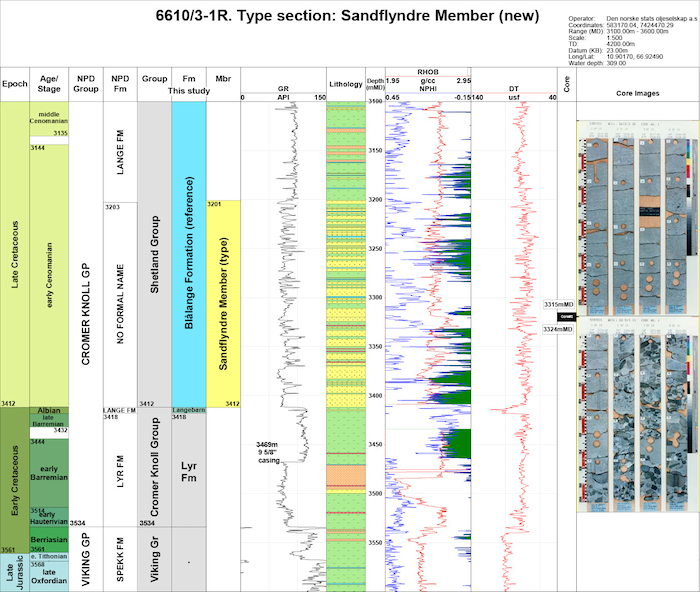 |
|
 |
|
updated to follow: Stratigraphic Guide to the Cromer Knoll, Shetland and Chalk Groups of the North Sea and Norwegian Sea. Felix M. Gradstein & Colin C. Waters (editors), Mike Charnock, Dirk Munsterman, Michelle Hollerbach, Harald Brunstad, Øyvind Hammer & Luis Vergara (contributors). Newsletter on Stratigraphy, vol 49/1 pp71-280, 2016
Shetland Group, Blålange Formation
Informal name: None.
The member consists of interbedded sandstones, conglomerates and mudstones. In the type well 6610/3-1R, 9m of core (core#2) was taken in the middle part of the member and shows both uniform, structureless, fine to medium grained grey sandstones and conglomerates with large (up to dm scale) rounded to sub-rounded clasts that are both grain supported and within a fine-medium sandstone matrix.
This member is the lowermost sandstone of the Blålange Formation (Shetland Group) and developed in the Vestfjorden Basin SW of the Røst Island, Lofoten Islands. It is also approximately time equivalent, i.e. Cenomanian age, to the geographically distinct Gapeflyndre Member (eastern Møre margin) and Smørflyndre Member (Dønna Terrace). This indicates input of coarse clastic sediments into basinal/terrace areas at this time.
WGS84 coordinates: N 66°55'29.70", E 10°54'06.28"
UTM coordinates: 7424470.29 N 583170.04 E
UTM zone: 32
Drilling operator name: Den norske stats oljeselskap a.s
Completion date: 11.12.1993
Status: Susp. reentered later
Interval of type section (m) & thickness in type well:
3412 m - 3201 mMD, 211 m thickness.

None designated.
Core was taken over a small percentage (4%) of the member in the type well 6610/3-1R, and this core may not be representative of the whole member. The member is interpreted as being deposited as basin floor/slope turbidites and mass gravity flows, and amalgamated channel and lobe, interlobe and lobe fringe and basin mudstones.